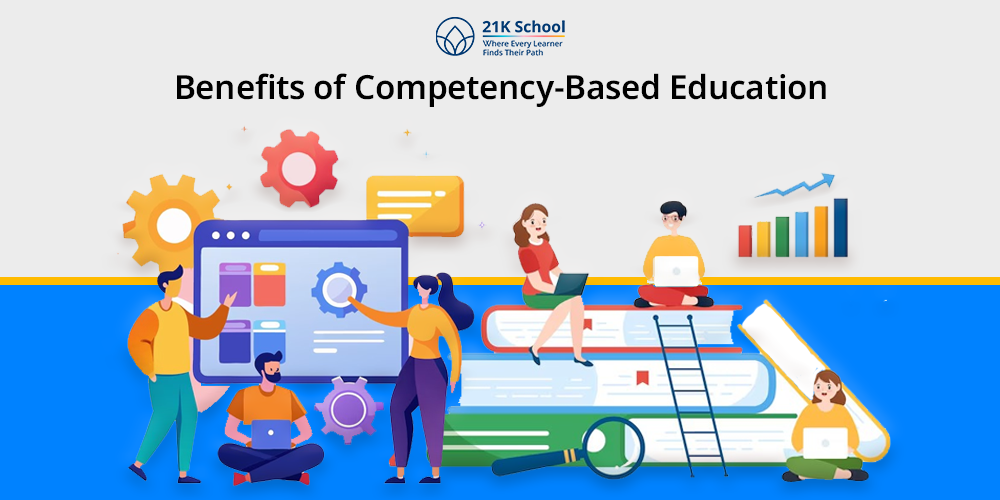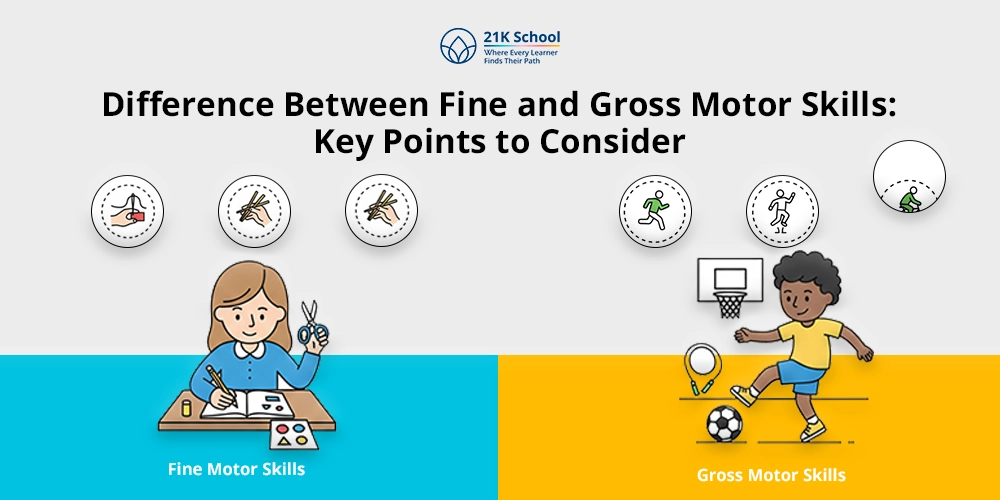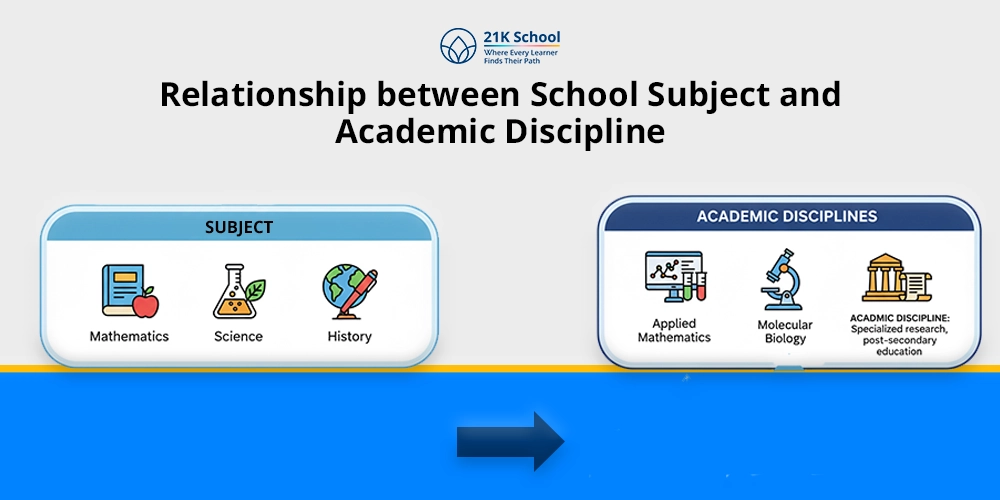
Do you know why competency-based education is essential for students’ career pursuits?
Competency-based education provides students with personalised and self-paced learning opportunities, which enable them to study as per their own flexibility.
As compared to traditional education, competency-based education allows children with mastery learning and provides student-centred learning methods.
Competency-based education is becoming popular because of its multiple benefits and practical exposure to subjects. This method helps children to study as per their own comfortability and convenience, allowing them to gain hands-on experience.
Competency-based education is based on the idea that students should acquire the knowledge and skills necessary to thrive in the real world.
Competency-based learning focuses on promoting holistic education and allows them to indulge in lifelong learning .
Table of Contents
- What is Competency-Based Education?
- Top 20 Benefits of Competency-Based Education:
- 1. Personalized Learning
- 2. Increased engagement
- 3. Assessment
- 4. Learning Outcome
- 5. Cost Savings
- 6. Flexible Self-Paced Learning
- 7. Enhanced Student Outcomes
- 8. Enhances Learning Experience
- 9. Flexibility
- 10. Improved Skill Mastery
- 11. Measuring Mastery
- 12. Prepares Students for the Future
- 13. Promoting Lifelong Learning
- 14. Preparation for Real-World Challenges
- 15. Self-paced Learning
- 16. Enhancing Student Motivation
- 17. Flexible Assessment Methods
- 18. Flexible Pathways
- 19. Development of Practical Skills and Knowledge
- 20. Instruction method
- Wrapping up
What is Competency-Based Education?
Competency-based education is a student-centric learning method that provides a framework for teaching and learning methods . Competency-based education focuses on practical skills, providing students with hands-on experience.
The concepts of the competency-based education framework include knowledge creation and application of meaningful forms of assessment, tailored student support and demonstrated mastery of a competency.
Unlike traditional schooling , which focuses on theoretical knowledge and the rote learning method, competency-based education allows students to learn from practical exposure.
In a competency-based education system, students demonstrate what they have learned and their skills in order to achieve specific predetermined “competencies.
Top 20 Benefits of Competency-Based Education:
Competency-based education has many benefits that enhance the learning process, raise student achievement, and prepare individuals for obstacles in both their personal and professional lives.
Competency-based education focuses on students’ knowledge retention and enhances their creative thinking skills and critical thinking skills .
Competency-based education, easy assessments, flexibility, enhanced engagement, self-paced learning and so on, which enhances students’ learning outcomes. The following are the benefits of competency-based education.
Explore in detail about competency-based education in NCF 2023
1. Personalized Learning
Competency-based education focuses on Personalised learning , which allows students to learn at their own pace. Competency-based education provides students with tailored content to their individual needs, interests and learning styles.
This personalisation allows students to engage with the material more deeply by focusing on subjects that interest them or require additional attention.
2. Increased engagement
Competency-based education is known for enhancing students’ engagement towards education and self-studies. Competency-based education promotes a higher level of engagement by aligning learning with students’ personal and professional goals.
Practical exposure allows students to relate their studies to real-world applications, through which they are more likely to invest time and effort in their education .
3. Assessment
Competency-based education uses multiple assessment methods, and sometimes it uses formative assessment tools to assess student performance. Competency-based education uses assessments to provide students with feedback on their performance.
This helps in identifying their strengths and weaknesses and enabling interventions, and supporting this ongoing evaluation helps avoid student’s stress and unequal evaluation.
4. Learning Outcome
Competency-based education helps in enhancing the learning outcomes of students through active learning.
Competency-based learning is based on well-defined learning outcomes that specify what knowledge and skills students should possess at the end of their education.
Through this method, students are better able to concentrate and develop analytical skills .
5. Cost Savings
Competency-based education can result in cost savings for both students and institutions.
Through competency-based learning, students can attend their classes through e-learning platforms , which helps in reducing their costs.
Through competency-based learning, students can progress at their own pace, which helps them complete their programs more quickly, which also reduces overall tuition costs and additional expenses.
6. Flexible Self-Paced Learning
Competency-based education provides flexible learning opportunities to students. This flexibility allows children to move through the course material at their own pace.
Through this flexibility, they can accommodate varying learning speeds and styles, which allows them to spend more time on difficult subjects and learn easy subjects more quickly through contexts they already understand.
7. Enhanced Student Outcomes
Competency-based learning helps in enhancing students’ outcomes, which leads to higher retention rates, improved academic performance and higher employment rates.
Competency-based education focuses on practical knowledge and mastery learning, which allows students to gain real-life experience and a deeper understanding of concepts.
This method makes learning more engaging and promotes sustainable education , allowing children to actively participate in their academics.
8. Enhances Learning Experience
Competency-based education helps in enhancing the learning experience of students through encouraging active learning by practical projects, group projects and real-world problem-solving .
This method involves interactive exercises and study techniques, which make education more interesting and applicable to students’ daily lives.
This helps in reducing study stress and promotes mastery learning.
9. Flexibility
Competency-based education provides flexibility, which helps in providing equal access to education.
Through the flexible nature of schooling, students can balance their studies with work, family and other responsibilities, which increases access to education.
As compared to traditional education , competency-based education allows children to learn at their own pace and learning style without following a structured learning environment.
10. Improved Skill Mastery
Competency-based education places more emphasis on skill mastery than classroom education.
Through mastery learning, students have to show that they have understood and are proficient in each competency in order to provide a solid foundation for future learning and application.
Skill mastery helps in promoting dynamic education and enables students to achieve their lifelong goals.
11. Measuring Mastery
Competency-based education helps in monitoring and evaluating progress, which provides teachers and students with precise metrics for measuring skill mastery.
These data-driven metrics help in identifying specific areas in which improvement is needed and support through intervention programs. This helps students to understand their weaknesses and create the best strategies to overcome their challenges.
12. Prepares Students for the Future
Competency-based education prepare students for the future opportunities, which places an emphasis on relevant skills and competencies prepares students for the demands of the workforce.
As competency-based education focuses on practical skills and mastery of knowledge, it enables students to gain hands-on experience and allows them to develop an entrepreneurial mindset .
This allows them to become more employable and achieve future opportunities.
13. Promoting Lifelong Learning
Competency-based education promotes lifelong learning and continuous improvement, which allows students to indulge in self-directed learning.
The benefits of lifelong learning enables students to become more adaptive in a competitive job market, which is changing quickly.
This also helps in enhancing knowledge retention and updating individuals with current trends and knowledge.
14. Preparation for Real-World Challenges
Competency-based education prepares students for real-world challenges through practical exposure and experiential learning . Competency-based education often incorporates real-world projects and scenarios, which allows students to acquire employable skills.
This hands-on experience allows children to become more capable of managing challenges in the workplace and find possible solutions to the problem.
15. Self-paced Learning
Competency-based education provides students with self-paced learning opportunities. Through self-paced learning, students can study at their own pace and learning style.
Students can balance their studies with other responsibilities, such as family or work by taking control of their education. This self-paced approach gives autonomy to students to direct their own education.
16. Enhancing Student Motivation
Competency-based education helps in enhancing students’ motivation. This allows students to advance their motivation according to mastery skills rather than a timed classroom.
This approach allows students to remain dedicated and interested in their studies when they can observe the results of their hard work.
Positive motivation towards education enables children to indulge in their academics and working life without any fear of failure.
17. Flexible Assessment Methods
Competency-based education has a flexible assessment method which helps in the evaluation of students’ performance.
Competency-based learning uses a flexible approach of assessment, such as project-based learning practical work, written assessment, oral assessment, and so on.
This flexibility not only accommodates different learning styles but also provides a more comprehensive evaluation of students comprehension.
18. Flexible Pathways
Competency-based education provides multiple learning pathways through which students can learn at their own pace. Students can choose from a variety of learning paths, allowing for a more individualised educational experience.
This flexibility enables students to align their education with their skills and aspirations. This method equips students with the skills and knowledge they need to thrive in an ever-changing environment.
19. Development of Practical Skills and Knowledge
Competency-based education places a strong emphasis on helping students acquire knowledge and skills that will be directly useful in their future careers.
This model of education creates a positive learning environment by allowing students to tailor their educational needs.
Competency-based education provides hands-on experience to students, enabling them to explore the real world. Through this method, students become more employable and prepared for the demands of the competitive job market.
20. Instruction method
Competency-based education uses a variety of teaching strategies such as experiential learning, online group projects , and activity-based classes and one-to-one classes. This diversity improves the educational process and accommodates different learning styles.
This allows students to study as per their own comfortability and choose their preferred learning styles. This method gives flexibility and freedom to study from their preferred learning styles.
Read about competency-based curriculum from here.
Wrapping up
Competency-Based Education (CBE) is a revolutionary method that emphasises individualised self-regulated learning and helps students gain the knowledge and skills necessary for their future employment.
Competency based education fosters lifelong learning while improving student engagement, motivation and results by emphasising mastery and practical applications.
In addition to preparing students for the demands of the workforce, this educational approach promotes a culture of adaptation and ongoing development.
Competency based education is becoming more and more popular because it gives students the tools they need to succeed both personally and professionally and provides a promising path for them to thrive in a changing job market.



